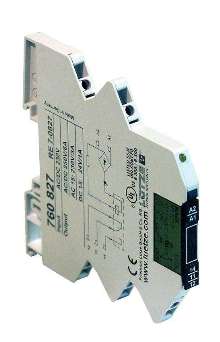Plug-In Relay Modules have terminals on front.
Press Release Summary:

Plug-in Coupling Modules are offered with normally open, normally closed, with changeover contacts, as well as in solid-state versions. They work from all power supplies ranging from 5-230 Vac/dc, and can switch AC or DC loads up to 250 V at 6 A. Using eject lever, defective relay can be swapped out without unclipping module itself. During initial installation, electrical connection is facilitated by screw terminals being accessible from front.
Original Press Release:
Plug-in Relay Modules Have Terminals on the Front
Coupling modules are widespread in automation technology. They minimize the financial costs of a control system, as relay cards are relatively expensive and inflexible when it comes to the number of outputs, which often drives the costs even higher. With the new relay modules the user can immediately start saving money in other areas: with the installation, the wiring and maintenance. They are the only ones with screw-terminals on the top designed as plug-in modules. If required the relays can simply be replaced using their built-in eject levers without having to unclip the complete module.
In order to open up further potential for rationalization by its customers, the Lütze company of Weinstadt, Germany now also offers its proven range of only 6.2mm wide Microcompact Coupling Modules with plug-in relay modules. In practice this new type of plug-in relay makes life easier in a whole range of different ways; using the eject lever incorporated in the module a defective relay can be swapped out quickly and easily, without having to unclip the whole module itself. During the initial installation electrical connection is facilitated by the screw terminals being accessible from the front. All potentials can be jumpered across several relays, e.g. using jumper-combs. The jumpers are arranged in such a way that they remain easily accessible even if fitted close together in rows.
The plug-in coupling modules are offered with normally open, normally closed and with changeover contacts, as well as in solid-state versions. They meet IEC 1131 requirements for control voltages and work from all normal industrial and vehicle power supplies from 5 to 230 VAC/DC. They can switch AC or DC loads up to 250V at 6A. Best practice use of LEDs integrated in the housing means that the current switching state of the module is always clearly signaled.




